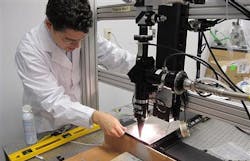Inline coherent imaging improves laser cutting accuracy in surgical applications
Kingston, ON, Canada--Medical and physics experts from Queen's University have developed a technique that significantly improves laser accuracy to the point where surgical cutting can be controlled to stop at a precise point—within 50 microns. The device is partially based on optical coherence tomography (OCT), which allows the user to see along the light beam that accompanies the cutting laser. Calling their adaption "inline coherent imaging", they can get depth images from the incision and essentially, see below the surface.
"A major problem that's really hindering laser application in major surgeries is that the light beam just keeps going," said James Fraser of Queen's University, the physicist who developed the device. The team includes Queen's PhD student Paul Webster, as well as Ben Leung, a former alumnus at the school who initially helped with the surgical application. Victor X. D. Yang of Ryerson University also helped with some medical direction.
The density and power of the cut, however, depend on the laser that the device is being applied to. The procedure would be effective, for example, on surgeries that involve accessing the brain. "Though the surgeon would have to be in final control, you could imagine that this would allow a semi-robotic method for operations."
Fraser said the new device will hopefully allow a number of advances, including: helping surgeons plan procedures ahead of time; completing procedures faster; reducing surgical complications; and improvements to post-operative implications.
Although the most prominent uses for controlling the depth of laser cutting are surgical and clinical, Fraser said the team is "very excited about the potential industrial applications," especially since compared to clinics it's easier to get new technology into industries. "In a few weeks, we'll be running industrially relevant processes," Fraser said. Those will likely include further testing on laser cutting and laser welding, which, for instance, are important techniques when working with automotive components—an area that experiences the same depth issue as surgery.
SOURCE: Ottawa Citizen; www.ottawacitizen.com/technique+significant+improvement+laser+accuracy/6473544/story.html
About the Author

Gail Overton
Senior Editor (2004-2020)
Gail has more than 30 years of engineering, marketing, product management, and editorial experience in the photonics and optical communications industry. Before joining the staff at Laser Focus World in 2004, she held many product management and product marketing roles in the fiber-optics industry, most notably at Hughes (El Segundo, CA), GTE Labs (Waltham, MA), Corning (Corning, NY), Photon Kinetics (Beaverton, OR), and Newport Corporation (Irvine, CA). During her marketing career, Gail published articles in WDM Solutions and Sensors magazine and traveled internationally to conduct product and sales training. Gail received her BS degree in physics, with an emphasis in optics, from San Diego State University in San Diego, CA in May 1986.
